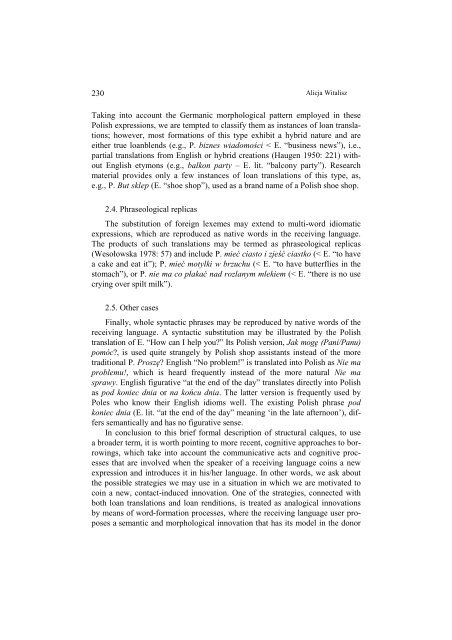s - Wyższa SzkoÅa Filologiczna we WrocÅawiu
s - Wyższa SzkoÅa Filologiczna we WrocÅawiu
s - Wyższa SzkoÅa Filologiczna we WrocÅawiu
Create successful ePaper yourself
Turn your PDF publications into a flip-book with our unique Google optimized e-Paper software.
230<br />
Alicja Witalisz<br />
Taking into account the Germanic morphological pattern employed in these<br />
Polish expressions, <strong>we</strong> are tempted to classify them as instances of loan translations;<br />
ho<strong>we</strong>ver, most formations of this type exhibit a hybrid nature and are<br />
either true loanblends (e.g., P. biznes wiadomości < E. “business news”), i.e.,<br />
partial translations from English or hybrid creations (Haugen 1950: 221) without<br />
English etymons (e.g., balkon party – E. lit. “balcony party”). Research<br />
material provides only a few instances of loan translations of this type, as,<br />
e.g., P. But sklep (E. “shoe shop”), used as a brand name of a Polish shoe shop.<br />
2.4. Phraseological replicas<br />
The substitution of foreign lexemes may extend to multi-word idiomatic<br />
expressions, which are reproduced as native words in the receiving language.<br />
The products of such translations may be termed as phraseological replicas<br />
(Wesołowska 1978: 57) and include P. mieć ciasto i zjeść ciastko (< E. “to have<br />
a cake and eat it”); P. mieć motylki w brzuchu (< E. “to have butterflies in the<br />
stomach”), or P. nie ma co płakać nad rozlanym mlekiem (< E. “there is no use<br />
crying over spilt milk”).<br />
2.5. Other cases<br />
Finally, whole syntactic phrases may be reproduced by native words of the<br />
receiving language. A syntactic substitution may be illustrated by the Polish<br />
translation of E. “How can I help you?” Its Polish version, Jak mogę (Pani/Panu)<br />
pomóc?, is used quite strangely by Polish shop assistants instead of the more<br />
traditional P. Proszę? English “No problem!” is translated into Polish as Nie ma<br />
problemu!, which is heard frequently instead of the more natural Nie ma<br />
sprawy. English figurative “at the end of the day” translates directly into Polish<br />
as pod koniec dnia or na końcu dnia. The latter version is frequently used by<br />
Poles who know their English idioms <strong>we</strong>ll. The existing Polish phrase pod<br />
koniec dnia (E. lit. “at the end of the day” meaning ‘in the late afternoon’), differs<br />
semantically and has no figurative sense.<br />
In conclusion to this brief formal description of structural calques, to use<br />
a broader term, it is worth pointing to more recent, cognitive approaches to borrowings,<br />
which take into account the communicative acts and cognitive processes<br />
that are involved when the speaker of a receiving language coins a new<br />
expression and introduces it in his/her language. In other words, <strong>we</strong> ask about<br />
the possible strategies <strong>we</strong> may use in a situation in which <strong>we</strong> are motivated to<br />
coin a new, contact-induced innovation. One of the strategies, connected with<br />
both loan translations and loan renditions, is treated as analogical innovations<br />
by means of word-formation processes, where the receiving language user proposes<br />
a semantic and morphological innovation that has its model in the donor
















